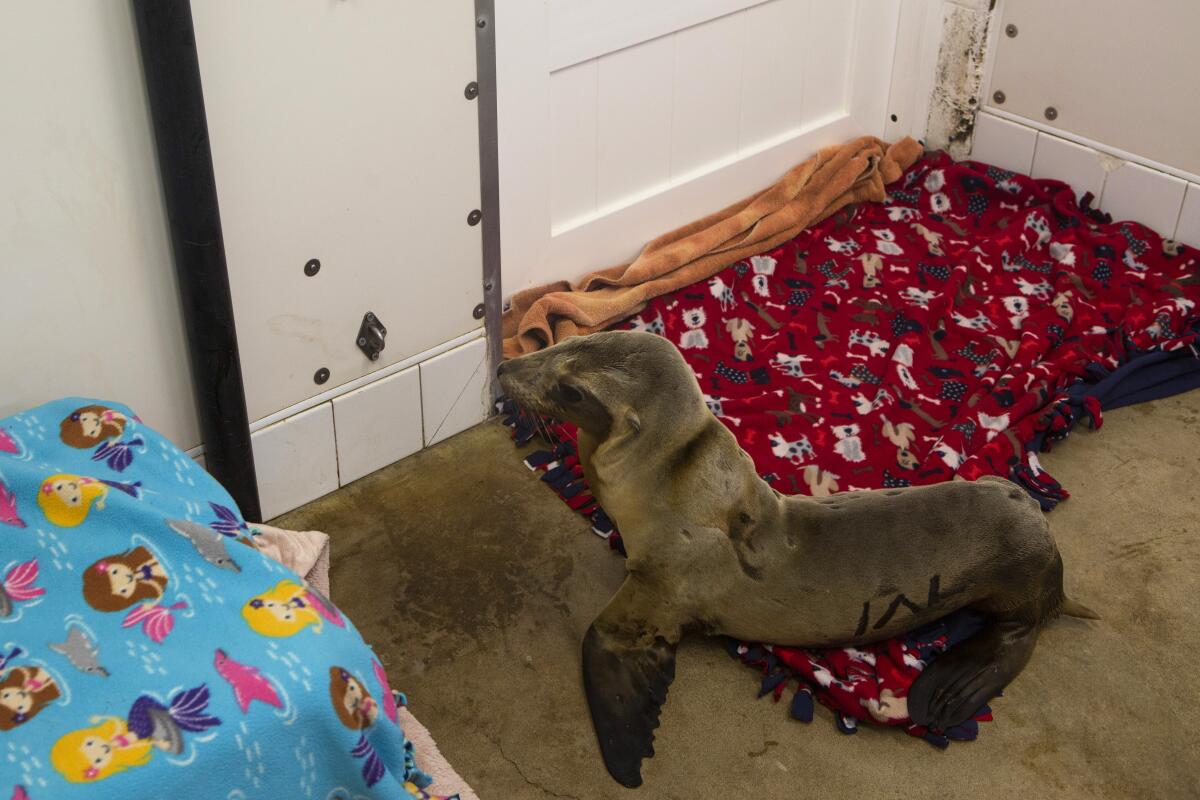Sea lion pup dubbed Lords-a-Leaping after daring jump onto Coast Highway

- Share via
A sea lion pup earned a festive new name — Lords-a-Leaping — after he went on a daring adventure this week, taking a 30-foot jump from a pedestrian bridge onto South Coast Highway in Laguna Beach.
Authorities responded to Aliso Beach bridge at Aliso Circle just above South Coast Highway on Monday night after receiving reports that a sea lion pup had climbed the bridge and was lounging there. The animal stayed put for about 40 minutes before leaping onto the highway below, Laguna Beach Police Sgt. Jim Cota said.
Officers helped block traffic while the rescue team from the Pacific Marine Mammal Center in Laguna Beach captured the 33-pound sea lion. Lords-a-Leaping did not have visible injuries or appear to have broken any broken bones, likely because bushes and branches broke the pup’s fall onto the roadway, according to officials from the center.
Despite his seeming resilience, the sea lion is dehydrated and emaciated and will need some recovery time, said Wendy Leeds, animal care coordinator at the Pacific Marine Mammal Center.
“He’s eating, and he’s a feisty boy,” she said. “He puts up a good fight whenever anyone tries to do anything with him. That’s a good sign.”
Lords-a-Leaping is among nine pups the marine mammal center has taken in since November, a number that officials say is unusually high so early in the season. The center took in three pups in November and six others — including two whom staff named Yoda and Leia — in December. The most recent sea lion was rescued on Christmas Day, Leeds said.
The center usually fields most of its calls about stranded pups in January or February. Officials suspect a “blob” of heat bubbling up in the Pacific Ocean could be to blame for the increased number, Krysta Higuchi, a spokeswoman for the rescue center, told the Los Angeles Times this month.
Experts are concerned that the weather pattern may grow, creating the same oceanic heat wave that developed between 2014 and 2015 and for years caused thousands of sea lions to become stranded along California’s coast.
The new weather pattern — officially called the Northeast Pacific Marine Heat Wave of 2019 — has developed over the last few months as a result of a high-pressure ridge that has damped winds and contributed to ocean warming. Researchers say the event is on its way to becoming as strong as the last blob and is already one of the most significant on record.
The effects could be as devastating to the ecosystem as the 2014 heat wave, but there is a chance the oceanic event is temporary.
“It looks bad, but it could also go away pretty quickly if the unusually persistent weather patterns that caused it change,” Nate Mantua, a research scientist at the Southwest Fisheries Science Center, said in a NOAA news release.
More to Read
Sign up for Essential California
The most important California stories and recommendations in your inbox every morning.
You may occasionally receive promotional content from the Los Angeles Times.















